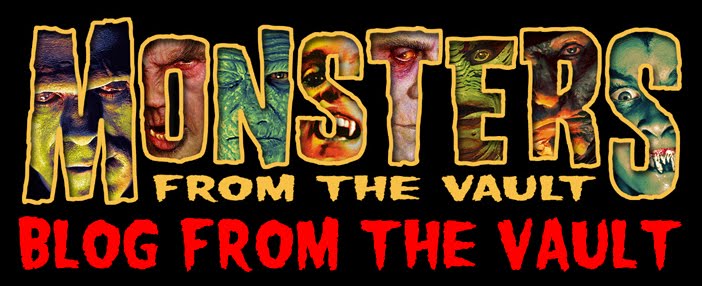TALES FROM THE CULT FILM TRENCHES: Interviews with 36 Actors from Horror, Science Fiction and Exploitation Cinema, by Louis Paul, Foreword by Tom Weaver (2008: McFarland & Company, Inc., Box 611, Jefferson, NC 28640). Softcover, $35.00.
Review by John Rozum
Before I begin, there's something I need to disclose. When I read a magazine I tend to skip interviews with actors, no matter how much I may enjoy their work, or how interested I am in the movie the interview promotes. This is not because I look down on them or think they don't have anything intelligent to say. The reason is that more often than not, they aren't given the opportunity to say anything interesting.
Most actor interviews I've read seem to be more about making the reader believe that the journalist who conducted the interview is now best buddies with the actor in question, and any quotes used tend to be fluff pieces about some hilariously embarrassing mishap on the set, or how dedicated their co-star is to his or her craft.
Reading Tales from the Cult Film Trenches was a refreshing contrast to my expectations regarding actor interviews. Author and interviewer Louis Paul works in the vein of Tom Weaver, who wrote the Foreword to this volume, in that Paul's admiration for his subjects shows through and allows him to ask well-considered questions that usually get well-considered responses. Where Weaver tends to focus on actors whose body of work was concentrated in the 1930s, 1940s, and 1950s, Paul picked subjects who worked in the subsequent three decades, making this book a wonderful companion volume to Weaver's.
Tales from the Cult Film Trenches contains interviews that Paul conducted with 36 actors best known for their work in genre movies, be they horror, science fiction, sword and sandal, biker, action, adult, or movies lumped under the problematic heading of blaxploitation. (As actor Fred Williamson points out, "I do not understand how they could use that terminology, because I don't know who was being exploited.")
While the actors in this book are best known for work they did in the '60s, '70s, and '80s, most of them are still working now. The first entry begins, "Tom Atkins is an actor whose name you may not readily recognize, but you’ll recognize his face if you were or are a fan of genre films of the eighties." That description easily applies to just about everyone in this book. These are character actors, and while many of them have had their moments playing lead characters, the meat and potatoes of their work is in supporting roles. Quite a few of these actors have made a career out of playing heavies.
The actors Paul chose for this collection are a diverse lot: Atkins, Adrienne Barbeau, Michael Berryman, Samson Burke, David Carradine, Robert Davi, Brad Dourif, Keir Dullea, Sid Haig, Tippi Hedren, Gloria Hendry, Richard Herd, David Hess, Brion James, Brigitte Lahaie, Ed Lauter, Christopher Lee, Marrie Lee, Valerie Leon, Richard Lynch, Charles Napier, Linnea Quigley, Steve Railsback, Tura Satana, John Saxon, Madeline Smith, William Smith, Austin Stoker, Don Stroud, Cary-Hiroyuki Tagawa, Dee Wallace Stone, Mel Welles, Fred Williamson, William Windom, Lana Wood, and Celeste Yarnall.
As can be expected in any book of this sort, the depth of the interviews varies from subject to subject. Some, such as Adrienne Barbeau, don't really say much, with each query being answered with, essentially, "That person was really nice and interesting to work with," or "I had a lot of fun working on that project." Fortunately, the bulk of the interview subjects have quite a bit to say, offering insights into their backgrounds, their craft, the films they've worked on, co-stars, directors, and the general economics of low-budget filmmaking and surviving as a rank-and-file character actor.
Aside from the interviews themselves, Paul also provides excellent biographical material as well as extremely thorough filmographies. The latter illuminate just how hardworking these mostly uncelebrated actors are, as many contain page after page of densely typed movie and television series names and dates. Paul also helpfully provided each episode name when discussing television series that featured the actors in nonrecurring roles.
These elaborate filmographies also highlight the only drawback to this book. It's sometimes disappointing, as in the case of William Windom, to find that despite a nearly five-page list of credits, Windom's interview is only about a page and a half long, focusing on just a couple of roles. Granted, I know each actor is different in how much time he or she allows for interviews and how cooperative he or she wants to be with the process, so I'm sure Paul did his best with whatever time or personality he was working with.
There is a lot of gold in this book. I learned a lot and was impressed by how much thought went into the responses to Paul’s questions; it was obvious the subjects enjoyed being interviewed by Paul. The actors who divulged how they approached their craft and viewed the types of movies they appeared in are the most fascinating interviews to read, and they make up the bulk of this book.
I'm very glad to have read this volume, and I recommend it to anyone whose love of cult and exploitation films extends beyond horror and science fiction to encompass the other genres mentioned above. I also recommend it to anyone interested in the history of motion pictures from the 1960s to 1980s or in the craft of acting. I'm looking forward to Paul’s next collection of interviews.


